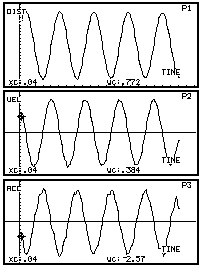



The plots x(t), v(t), a(t), f(t) position, velocity acceleration and force vs. time show a behavior clearly sinusoidal. It may be shown how to create fitting functions to various curves, phaseshifts may be discussed …
By moving the cursor on the screen, period measurements may be performed showing that the period is amplitude independent, as expected for an harmonic oscillator (isochronism)
The plot f(x) force-displacement results to be linear, and the slope obtained from the fit gives the elastic constant k of the spring.
The plot a(x) acceleration- displacement results to be linear, and the slope (k/m) obtained from the fit gives the inertial mass mi, once known k.
The experiment may be repeated with a different mass and then with a different spring to show the period dependence on sqrt(m/k)
Within the DataMatrix Editor environment, columns with the calculated values of potential energy (gravitational, elastic), kinetic energy and total energy may be generated. Plots of the calculated energies vs. time allow to demonstrate the energy transformations as well as to calculate the damping coefficient (nearly exponential decay). Oscillations at large amplitudes show that energy is dissipated discontinuously (larger dissipation corresponding to velocity peaks) by viscous friction.